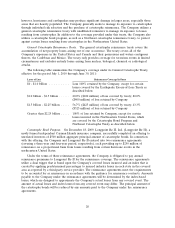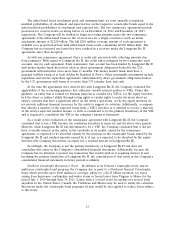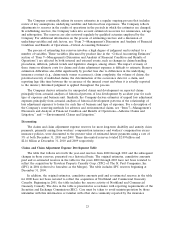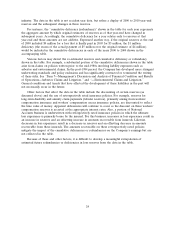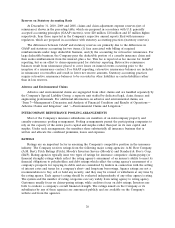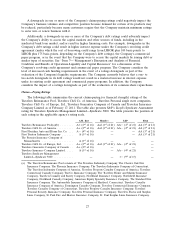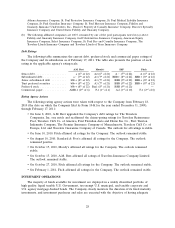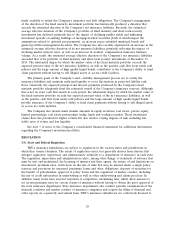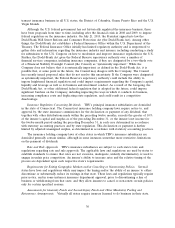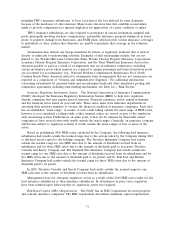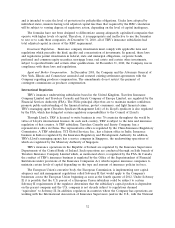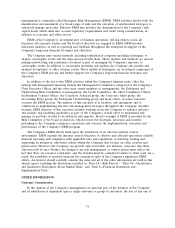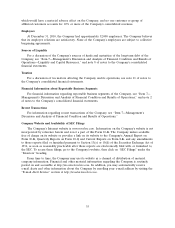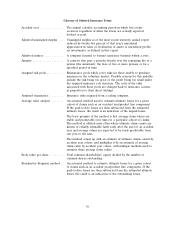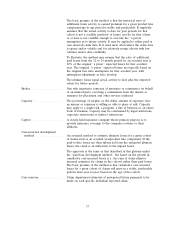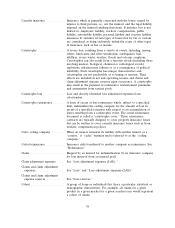Travelers 2010 Annual Report Download - page 41
Download and view the complete annual report
Please find page 41 of the 2010 Travelers annual report below. You can navigate through the pages in the report by either clicking on the pages listed below, or by using the keyword search tool below to find specific information within the annual report.funds available to satisfy the Company’s insurance and debt obligations. The Company’s management
of the duration of the fixed maturity investment portfolio has historically produced a duration that
exceeds the estimated duration of the Company’s net insurance liabilities. Recently, the estimated
average effective duration of the Company’s portfolio of fixed maturity and short-term security
investments has declined, primarily due to the impact of declining market yields and tightening
investment spreads on existing holdings of mortgage-backed securities (both of which impact the
assumptions related to optional pre-payments), an increase in pre-refunded municipal bonds and
general portfolio management decisions. The Company has also recently experienced an increase in the
estimated average effective duration of its net insurance liabilities, primarily reflecting the impact of
declining market interest rates, as well as an increase in workers’ compensation insurance business
volume. As a result, the estimated average effective duration of the Company’s net insurance liabilities
exceeded that of its portfolio of fixed maturity and short-term security investments at December 31,
2010. The substantial degree by which the market value of the fixed maturity portfolio exceeds the
expected present value of the net insurance liabilities, as well as the positive cash flow from newly sold
policies and the large amount of high quality liquid bonds, contributes to the Company’s ability to fund
claim payments without having to sell illiquid assets or access credit facilities.
The primary goals of the Company’s asset—liability management process are to satisfy the
insurance liabilities and maintain sufficient liquidity to cover fluctuations in projected liability cash
flows. Generally, the expected principal and interest payments produced by the Company’s fixed
maturity portfolio adequately fund the estimated runoff of the Company’s insurance reserves. Although
this is not an exact cash flow match in each period, the substantial degree by which the market value of
the fixed maturity portfolio exceeds the expected present value of the net insurance liabilities, as well
as the positive cash flow from newly sold policies and the large amount of high quality liquid bonds,
provide assurance of the Company’s ability to fund claim payments without having to sell illiquid assets
or access its credit facilities.
The Company also invests much smaller amounts in equity securities, real estate, private equity
limited partnerships, real estate partnerships, hedge funds and trading securities. These investment
classes have the potential for higher returns but also involve varying degrees of risk, including less
stable rates of return and less liquidity.
See note 3 of notes to the Company’s consolidated financial statements for additional information
regarding the Company’s investment portfolio.
REGULATION
U.S. State and Federal Regulation
TRV’s insurance subsidiaries are subject to regulation in the various states and jurisdictions in
which they transact business. The extent of regulation varies, but generally derives from statutes that
delegate regulatory, supervisory and administrative authority to a department of insurance in each state.
The regulation, supervision and administration relate, among other things, to standards of solvency that
must be met and maintained, the licensing of insurers and their agents, the nature of and limitations on
investments, premium rates, restrictions on the size of risks that may be insured under a single policy,
reserves and provisions for unearned premiums, losses and other obligations, deposits of securities for
the benefit of policyholders, approval of policy forms and the regulation of market conduct, including
the use of credit information in underwriting as well as other underwriting and claims practices. In
addition, many states have enacted variations of competitive ratemaking laws, which allow insurers to
set certain premium rates for certain classes of insurance without having to obtain the prior approval of
the state insurance department. State insurance departments also conduct periodic examinations of the
financial condition and market conduct of insurance companies and require the filing of financial and
other reports on a quarterly and annual basis. TRV’s insurance subsidiaries are collectively licensed to
29



